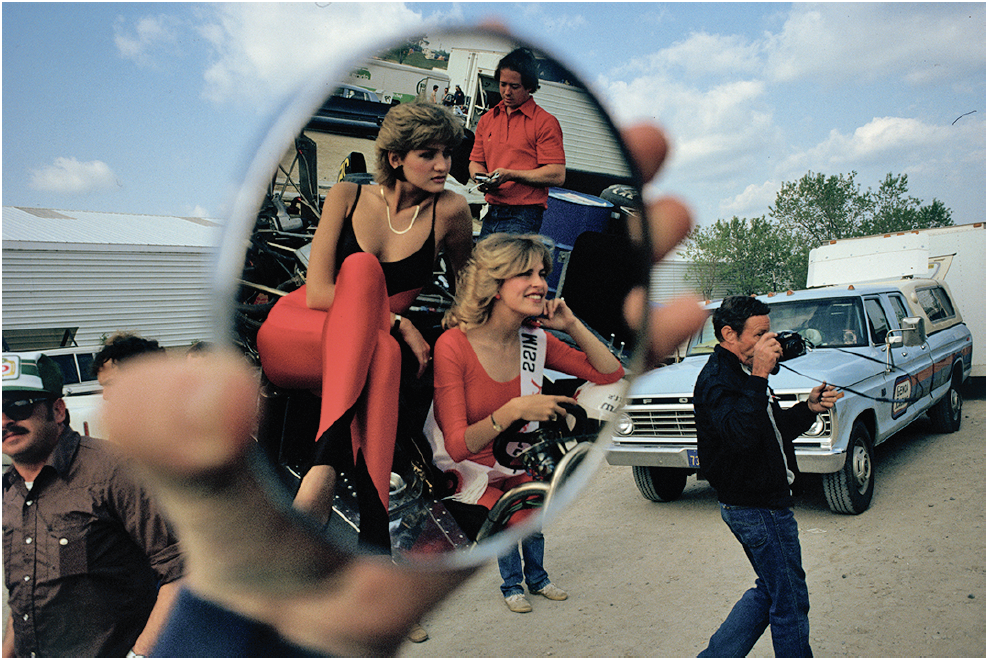Iain Baxter&
Iain Baxter&’s photograph of a New York City street at dusk (Dusk, New York, New York, 1971) is about as eerie as they come these days. The scene is hemmed in on one side by an expanse of dark, fire-escape-clad buildings and a long row of parked cars on the other. The air, hanging heavily as if it were about to rain, is punctuated by glowing street lights. In the foreground, just out of focus, a man walks unsuspectingly toward the camera. Captured here in his 1970s stroll, he doesn’t know that the landscape behind him will one day be famously changed. There, almost invisible thanks to dusk’s diffuse light and a smog-smeared urban sky, lurk the newly completed twin towers of the World Trade Center. Their presence feels like ghostly foreshadowing—looming large in the background, yet almost invisible at first glance. In fact, it’s the hazy sky that makes this image so eerie—an unintentional precursor to the endless New York street scenes we saw in the post-attack days, the skies thickened with dust and debris. This photograph’s power lies in what’s revealed after prolonged looking. A cursory glance divulges just the superficial streetscape—the fog-clad towers announce themselves only after you’ve allowed your gaze to linger over the sidewalk, taking in the vehicles and street lights and pedestrians. Baxter&’s skillful composition leads the eye more deeply into the image, compelling us to find what counts.

Iain Baxter&, Dusk, New York, New York, 1971, Duratran light box, 121.9 x 91.4 x 14 cm. Courtesy Corkin Gallery. Image courtesy Art Gallery of Windsor.
Indeed, Baxter&’s gift as a photographer is in this ability to have us reconsider what appears at first glance to be mostly ordinary. Whether he’s capturing a highway in northern California, a scene at the Pacific National Exhibition or a generic hotel room, Baxter&’s images ask us to be with him in the moment. The reward—like twin towers out of the fog—comes after deliberate looking. There is also, we soon find, humour in his compositions, quirkiness, too, along with unabashed style, a deliberate use of colour and a skillful ability to have us look upon the everyday with fresh eyes.
Taken over a 25-year period mostly spanning the ’60s and ’70s, this collection of rarely seen photographs, organized and toured across the country by the Art Gallery of Windsor, serve as both documents and unique works of art. They feel at once like snapshots and carefully considered studies, capturing both an optimistic young country and a young man’s observations as he travels it. They reveal the movement, hope, industrial growth and consumption of the times. And as often as the works are dated by their subject matter—cars, clothing and furniture long out of style—there is an easy timelessness about them, too.
In Highway, Northern California, 1979, for example, the frame is bisected by a diagonal swath of red-pink asphalt running up the centre of a highway between two lanes of grey. The greys and pinks of the highway are picked up again in the blues and dull reds of the receding landscape, creating a unified and deeply satisfying image. It’s clear that Baxter&’s keen eye was unable to resist capturing this tasty scene, even though he was driving—the framing reveals the photographer’s arm in the rearview mirror. Only a beefy muscle car on the right hand grounds the image to a specific time. In Wheels, Vancouver, British Columbia, 1968, Baxter& reduces a mint-green truck trailer to a study in shape, form and colour, two small wheels punctuating the swath of green like rubber islands. It, too, transcends time, drawing our attention instead to beauty in the mundane.

Iain Baxter&, Racing Queens, Mosport International Raceway, near Bowmanville, Ontario, 1983, chromira print, 106.7 x 148 cm. Courtesy Corkin Gallery. Image courtesy Art Gallery of Windsor.
As a photographer, Baxter& also seems taken with the spaces where textures and colours intersect. Whether capturing stacks of toy-blocklike fruit crates (Fruit Crates, Okanagan Valley, British Columbia, 1965), a 1970s Toronto strip mall (Strip Mall, Toronto, Ontario, 1974), all optimistic neon reflected in parking lot puddles, or a potted tree against an amateur painted landscape in a restaurant (White Spot Restaurant Landscape, Vancouver, British Columbia, 1967) Baxter& appears engaged with the collisions between incongruous patterns and things and wants us to notice them too. Trucks, Near San Francisco, California, 1966, is particularly delicious in this regard. In it, a lengthy row of open-backed trucks awaiting content are reduced to a graphic line of latent potential that divides earth from sky. Sometimes he’ll even hold up a small circular mirror in his shots, creating compositions that reveal not only what’s before the camera, but what’s behind it, reminding us that, ultimately, a photograph is nothing but a truncated view. In Racing Queens, Mosport International Raceway, near Bowmanville, Ontario, 1983, for example, a man aims a camera at something out of frame, his body indicating a certain fevered urgency. Framed in a mirror is our reveal: two red-spandex-clad beauty queens posing for his camera.
These photographs take us on mini-journeys, encouraging us to meander through Baxter&’s compositions and out into the world as he saw it then. Whether he’s photographing shaggy-haired kids on a Kitsilano Beach, rows of liquid dish detergent or great swaths of blue sky over the tops of wooden roller coasters, Baxter& uses his camera to find the absurdity, beauty and humanity in it all. ❚
Passing Through: Iain Baxter& Photographs,” curated by James Patten, was toured by the Art Gallery of Windsor and exhibited at the Art Gallery of Nova Scotia in Halifax from February 28 to May 18, 2009.
Meredith Dault is a freelance writer based in Halifax.

